Cayenne pepper powder is an essential ingredient for making food spicier. It can add lots of heat while only minimally changing the flavor. In this article, you’ll learn how to dry cayenne peppers and how to make cayenne powder at home. We will assume you have a good amount of fresh cayenne peppers from the garden (hurray!).
When you harvest your homegrown cayenne peppers, you’ll have to decide how to use them. Whether you dehydrate them for flakes or powder, or use them fresh, you have limited time before they spoil.
With cayenne peppers, we almost always dehydrate most of them due to the abundance of peppers we get off of each plant. They are not great peppers for pickling due to their thin walls. This makes cayennes the perfect peppers for drying and grinding into spicy powder.
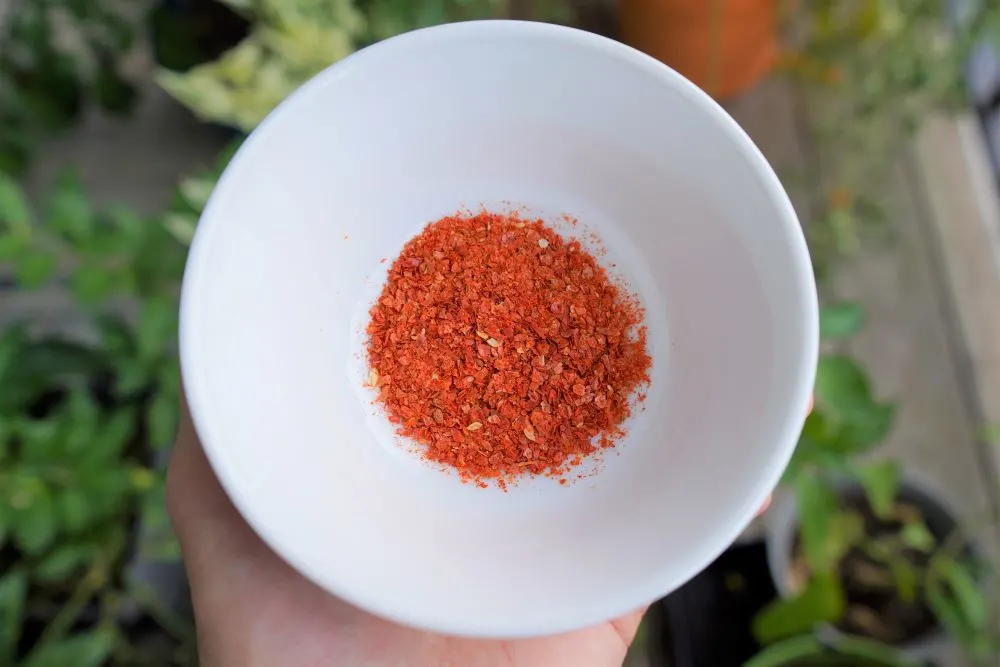
Keep in mind that the methods used in this article will work for other pepper varieties as well. However, we wrote specific articles for dehydrating jalapenos or habaneros here.
In This Article:
- In the dehydrator
- In the oven
- How to make cayenne powder
- Storing dried cayenne peppers
- How to use dried cayenne peppers
How To Dry Cayenne Peppers in a Dehydrator
The best way to dehydrate any food is to use a food dehydrator. These mini convection ovens are purpose built with dehydration in mind. This means low temperatures, between 110-165°F, circulated air, and open-bottom trays.
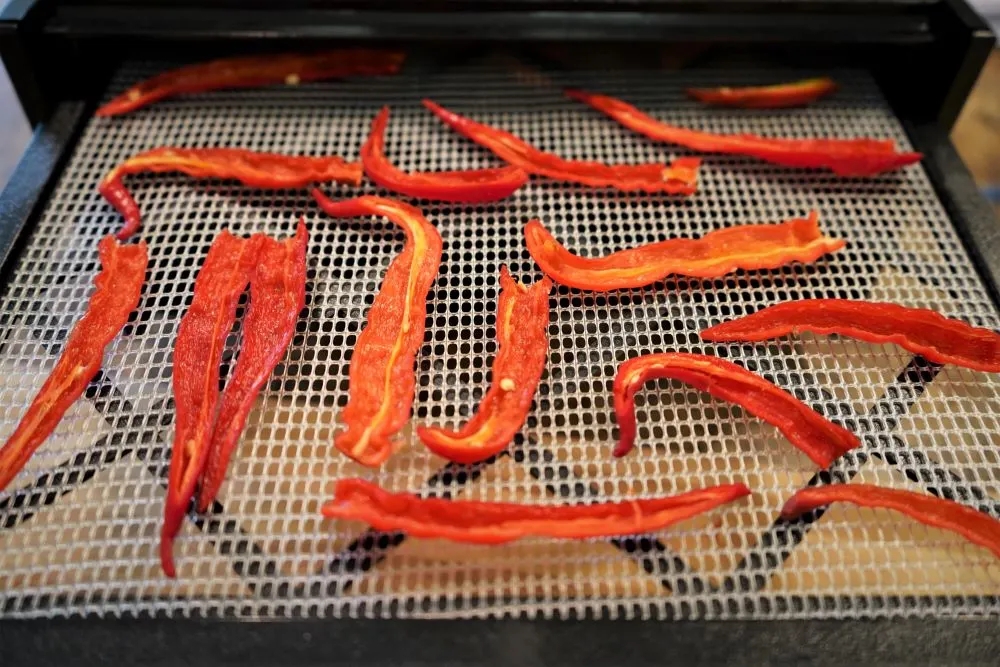
Should I Buy A Dehydrator?
Since we dry peppers, fruits, and even make beef jerky sometimes, we use this dehydrator.
It is tons of fun to make homemade snacks and preserve all kinds of foods from the garden. This doesn’t mean you need a dehydrator to dry cayenne peppers, but they will do the job best.
Some new toaster ovens, like this one, have a dehydrate option built in. And despite it being a last resort, a conventional oven will also work, it will just take much longer and may cause cooking to occur due to higher temperatures.
How To Dry Cayenne Peppers in the Dehydrator
- Wash and dry the peppers. Always pick healthy looking peppers and give them a good rinse under cold water. Dry them off after cleaning to reduce the drying time in the dehydrator.
- Wear gloves. Cayennes are no joke in the heat department (~50,000 SHUs). Without gloves, you will end up with a chili burn on your hands, so use some protective gloves.
- Cut off stems and slice lengthwise. Remove the stems and carefully slice the peppers lengthwise. This can be tricky given the shape of cayennes, so be careful.
- Remove the seeds and placenta. Use a spoon to scrape out the seeds, moving from the top of the peppers down to the ends. You can set them aside and save the seeds for growing next year if you’d like.
- Arrange peppers on trays. Arrange the cayenne peppers on the dehydrator trays with enough space between them to allow for airflow.
- Dehydrate at 120°F for 6-10 hours. Dehydration times may vary based on the environment. Cayennes are thin-walled peppers so they will typically be dry before jalapenos or bell peppers.
Note: The peppers should be completely stiff and should crack when bent. Since we will be making a powder, the peppers should be completely dried to this level. If you plan to keep the peppers whole, you can dry them to a leathery texture instead. - Grind or store dried cayennes. We always grind our cayennes into a powder, but you can also store them full sized for re-hydration later on. They should keep in an air-tight container for up to a year.
Skip ahead to how to grind cayenne peppers here. There are some important precautions to take!

Why Remove The Seeds?
If you want your pepper flakes or powder to be spicier, you can leave the seeds and placenta in. By taking them out, the powder will be a richer red color without the flecks of white.
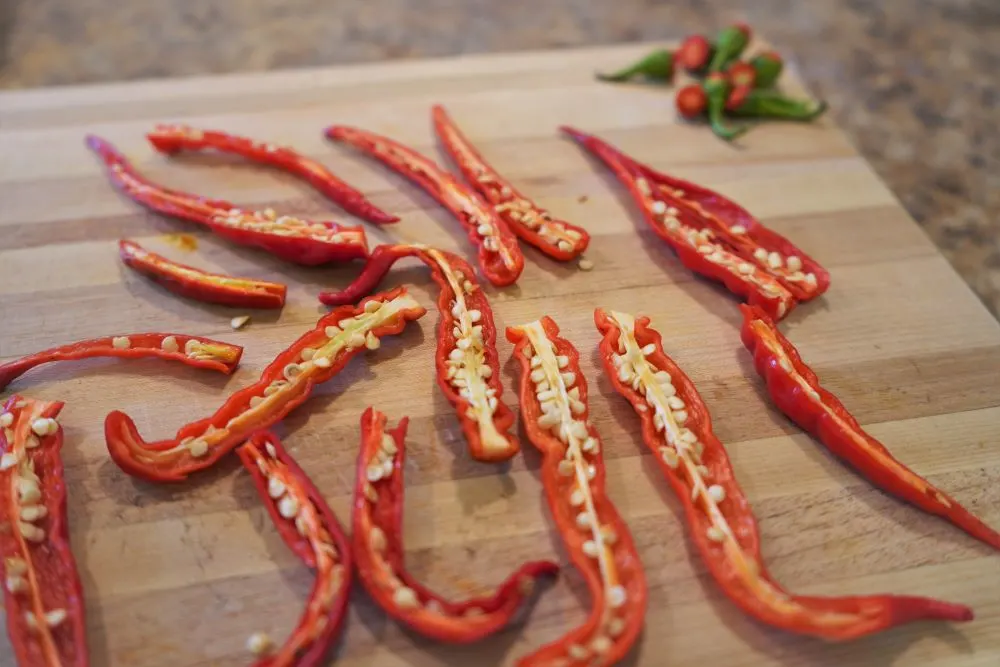
How To Dry Cayenne Peppers in the Oven
While we use a dehydrator regularly, some folks just can’t justify owning one. Thankfully, you can just as easily use an oven to dry cayenne peppers.
The drawbacks of using the oven are that the temperature typically won’t be low enough, the air may not be circulated, and the trays may not allow for enough air flow. These factors combine to create longer drying times and often discoloration due to unwanted cooking.
However, flavor and dryness should not be affected. The preparations are the same as when using a dehydrator, so feel free to skip to the arrangement step where instructions change a bit. Otherwise, follow these steps for how to dry cayenne peppers in the oven.
How to Dry Cayenne Peppers in the Oven
- Wash and dry peppers. Pick healthy peppers and give them a good rinse and dry.
- Wear gloves. Gloves will save you from burning hands later on, trust me!
- Remove stems and slice lengthwise. Remove the cayenne stems and slice them in half lengthwise.
- Remove seeds. This step is optional, but removing the seeds prevents a chunkier powder and reduces the heat level a bit.
- Arrange on an oven-safe drying rack. In order to get evenly dried cayennes, you should use an open-bottomed tray, like a cookie drying rack. These come standard with any food dehydrator.
However, don’t just place the peppers on your oven’s racks, as the peppers will shrink and shrivel during the process and may fall through. Place the cookie drying sheet on top of a standard baking sheet to avoid any lost peppers. - Set temperature as low as it will go. Conventional ovens will typically not go below ~160°F, but if yours goes down to 120°F, set it there! With a temperature of 160° or higher, the peppers will likely cook slightly during the dehydration process. This can cause the peppers to change to a deeper color.
- Dehydrate until peppers are stiff. In the oven, this may take as long as 14 hours, but if you have a convection oven, it should be much less, between 6-10 hours. Since we will be grinding into a powder, we want the cayennes to be completely stiff and brittle. This will allow the peppers to easily break up in the food processor or spice grinder.
After dehydration, you can immediately store the cayenne peppers in an airtight jar, or you can move on to grinding the peppers. For grinding, we use a food process, but you can use a spice grinder if you have one for a finer powder.
How To Make Cayenne Powder
Cayenne peppers are the only thing you need to make your very own homemade cayenne pepper powder. This common ingredient for cooking is the perfect way to make food spicier without altering the flavor too much.
Read Next: Cayenne vs paprika vs chili powder
To make cayenne powder, we’ll use our completely dehydrated cayenne peppers. Make sure your peppers have been dried thoroughly enough. This means that the peppers should snap in half easily when bent.

How To Make Cayenne Powder
- Completely dehydrate the peppers. See above for instructions on how to dry your cayenne peppers.
- Place dried peppers in a spice grinder. While a spice or coffee grinder is ideal for making a fine powder, a food processor will grind the peppers into tiny flakes. For the closest thing to store bought consistency, invest in a spice grinder. Bonus: Your next batch of ground coffee may have a bit of a kick!
- Cover the grinder with a damp towel. Cayenne peppers are spicy, meaning that the fine particles that escape during grinding will irritate your lungs. The hotter the pepper, the more careful you should be when grinding. Cover the grinder before turning it on!
- Grind to desired consistency. If you want a fine powder, use a spice grinder – you may wish to get a dedicated grinder if you plan to make a lot of spicy powder. A food processor works if you are going for a flaked texture. The finer the powder, the more caking issues you may have with your cayenne powder.
- Let sit for 5 minutes before opening. Don’t open the grinder immediately, allow the particles to settle. You can also cover your face with a mask or damp kitchen towel when opening the processor.
- Store in a spice container. Dried peppers can keep for up to a year when properly stored in an airtight spice container.
Storing Dried Cayenne Peppers
When storing dried cayenne peppers, you want to keep the air within the container dry. We recommend using a desiccant packet if the peppers are whole, but this is not necessary for powder.
Dried cayenne peppers should last up to a year when stored properly. Be sure to check for any signs of mold whenever you use the peppers. If your container contained any water or moisture when you initially stored the peppers, it may invite the growth of unwanted molds.
How To Use Dried Cayenne Peppers
When it comes to using your dried cayenne peppers, you have options! Here are a few ways to use your cayenne powder or whole dried peppers.
- Spice up dishes by the 1/4 tsp. Add a pinch here or there for some fiery heat. This is the mail usage of cayenne powder in dishes.
- Make chili oil. Delicious, easy way to add heat and savory flavor to your soups, stews, stir fry and more. Essential ingredient in many Chinese dishes.
- Make a spicy rub. Make the perfect spicy chili spice blend using your own cayenne pepper powder – nothing is more satisfying!
- Make hot sauce. Though fresh peppers are preferred when making hot sauce, cayenne powder can be used to increase heat level and add a rich red color.
I hope this article helped you learn how to dry cayenne peppers for storage or powder! We like growing cayenne peppers for their abundantly productive plants. Feel free to leave a comment below with any questions or suggestions.


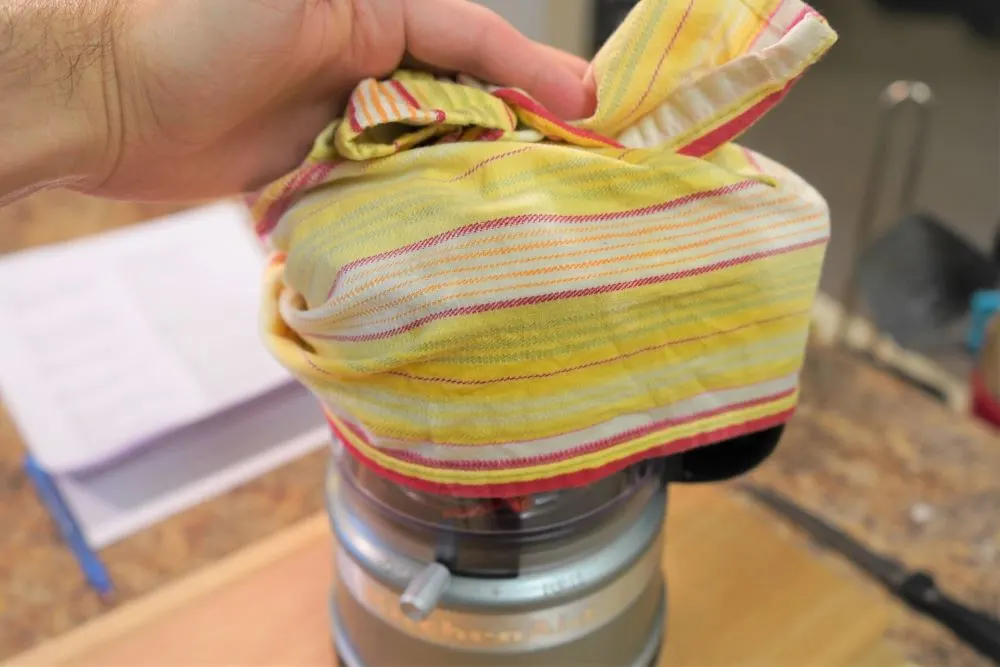
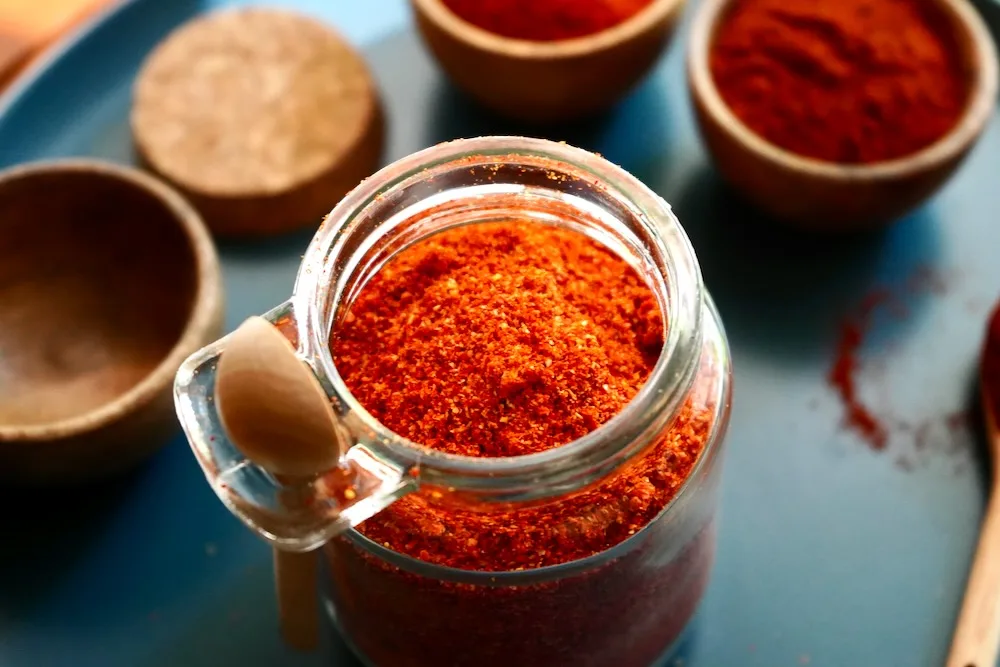

Ian
Monday 25th of March 2024
Hi! Thanks for the article! I noticed in one of your videos you had powders of different colors. Which peppers did you use? Also, what is the best method of drying to maintain color?
peppergeek
Tuesday 26th of March 2024
We like to dry a wide variety of peppers, green jalapeños, red cayennes, superhots like ghosts and habaneros, and the C. baccatum varieties make a fruity powder (aji amarillo, etc.)!
David Niemi
Tuesday 24th of October 2023
Slightly off-topic, but I just finished dehydrating (with a dehydrator) and grinding up (with mortar and pestle) 51 Dorset Naga peppers. I had to do the dehydrating in the garage because even cutting them made a pretty strong, acrid smell, that mellowed out to a more smoky woody smell by the next morning. They filled over half of a glass spice jar, which should last me for a long time -- I can't imagine using more than a pinch at a time given their heat level. Last time I used this method was on ghost peppers, which kept for years and were quite useful, though Dorset Nagas are about 50% hotter and more pungent. (To be honest, this is about the only useful purpose I've found for superhots, so growing them once every few years is plenty in my book).
peppergeek
Wednesday 25th of October 2023
Couldn't agree more - superhots are for extreme heat seekers, or for normal spice lovers in very small doses. Great to have a small amount go such a long way, but the plants also produce a TON
Christos
Sunday 16th of July 2023
I want to start a business producing Australian Organic Cayenne Pepper and would appreciate as much information as possible. Thankyou so much
Rob
Sunday 18th of September 2022
Info on air drying? Should I in put a slice each to promote air circulation?
peppergeek
Monday 19th of September 2022
No, usually air-dried peppers are left whole/uncut to avoid mold issues. Cayennes are good candidates for air drying as their skin is thin. Thicker skinned peppers often end up with mold before they dry. BTW, air dried pods are the best for flavor!
[email protected]
Monday 29th of August 2022
What color are the seeds when you cut it open
peppergeek
Wednesday 31st of August 2022
They should be ivory/white in color